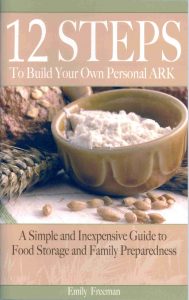
12 Steps to Build Your Own Personal ARK by Emily Freeman is a short, 28-page, simple guide to building basic food storage on a monthly basis, becoming more prepared for emergencies, and becoming more spiritually prepared. The booklet is definitely geared to Latter-day Saint readers and assumes the reader has access to a Latter-day Saint bookstore and a Home Storage Center.
Each of the 12 steps, or months, have goals in each of 3 categories which build your ARK:
A – A Year’s Supply
R – Required Reading and Family Study
K – Keeping the Ark Afloat
A – “A Year’s Supply” is based on the 2002 letter from The First Presidency of The Church of Jesus Christ of Latter-day Saints which gave a second option for basic food storage amounts – 400 lbs. grains, 60 lbs. legumes, 60 lbs. sugars, 10 quarts oil, 16 lbs. milk, 8 lbs. salt. (see Basic Food Storage) A few additional foods are also included – canned soup, tuna, peanut butter (which is also a high fat legume or a high protein fat), and yeast. The amounts suggested are for 2 adults. Most monthly suggestions are varied rather than 1 or 2 foods, which is good.
Suggested foods and the amounts are organized to cost about the same each month. Prices have changed since the book’s 2003 publishing date. Based on November 2011 Home Storage Center prices and reasonable guesstimates on the other items, the monthly amounts now range from $50 to $114 with an average cost of $79. It would be necessary for most people to be financially committed to this plan to be able to achieve it in 1 year, especially if purchasing for more than 2 people. (2023 prices are considerably higher and range from a low of about $54 [mostly inexpensive varieties of canned soup] to a high of about $220. Average cost is $147 per month based on home storage center prices and housebrand items.)
There are also a few recommendations that may be difficult to purchase without some refiguring:
–yeast is measured in packets. What is a packet? 1 envelope? A strip of 3 envelopes? A jar? A 1 lb. brick?
–shortening is measured in 2 lb. increments but shortening is most often purchased in 3 lb. cans.
–salt is measured in pounds but most people purchase salt in 26-ounce cylinder boxes.
–peanut butter is measured in pounds but most jars are more than or less than 16 ounces.
After a year, you will have the following amounts, not the amounts indicated in the book:
520 lbs. wheat
265 lbs. flour
125 lbs. sugar
120 lbs. beans
3 gallons oil
8 lbs. shortening
15 cans tuna
5 lbs. peanut butter
6 packages yeast
80 cans soup
16 lbs. salt
52 lbs. powdered milk
10 lbs. spaghetti
Using the recommendations from the previously mentioned First Presidency letter, grains will be short by 5 lbs. and even more if you only buy the recommended number of #10 cans; sugar will be over by 5 lbs.; beans will be okay; fats will be short 8 lbs.; salt will be okay; and milk will be over by 20 lbs.
The 12 steps to basic food storage in a year is a helpful idea but the explanation of it should have been more carefully thought out and cross checked. The numbers are not consistent between the explanation and the application. Also, there could be more variety without increasing the cost substantially.
R – “Required Reading and Family Study” is ideas to use for a monthly family meeting or a family home evening. Subjects include financial principles, 72-hour kits, water storage, emergency fuel, emergency drills, first aid, gardening, and various scripture studies on preparedness.
K – “Keeping the Ark Afloat” gives suggestions for non-food items, tools, and equipment. These include a can opener, wind-up clock, games, cleaning supplies, blankets, water, fuel, tools, toiletry items, first aid supplies, candles, a porta potty, seeds, and a food storage cookbook. This goal will require an additional financial commitment each month.
The book also includes quotes on preparedness by Latter-day Saint General Authorities, a simple inventory accumulation chart, and an inventory rotation chart.
The inclusion of a rotation chart almost contradicts one statement made in the book: “Obviously this food storage is not what we are used to eating on a regular basis,…” My question is “Why not and why should it be obvious?”
I also take issue with another statement made: “I am interested only in a basic food storage program. One that will sustain the life of every person in my family.” I believe that the attitude in both statements exhibits obedience to the letter of the law and not the spirit of the law. Letter of the law obedience is not true provident living which is one of the purposes of having food storage.
There is one quote in the book that is worth pondering over – “Educated, organized, and supplied to function in a crisis situation. A crisis is only a crisis when we are unprepared. For every worry under the sun there is a remedy. If there is a remedy, hurry and find it.”
This book is an inexpensive guide for starting basic food storage and emergency preparedness but to learn how to store a variety of food properly and use it, you will need another book or books.
